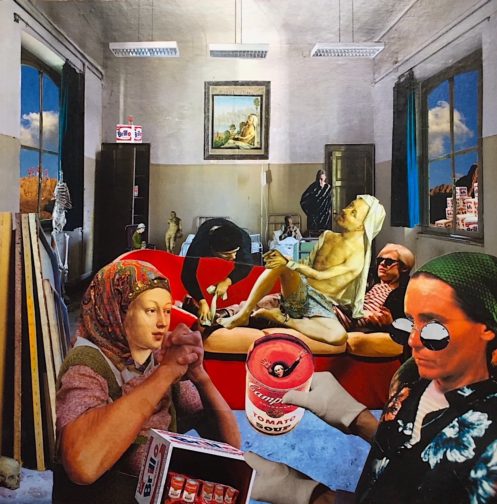
The Relaunching of Larry
December 2017. I’m reading an essay by Owen Hulatt, a teaching fellow in philosophy at the University of York. The title: Has art ended again? He uses up 3100 words considering the death of art. I am using fewer by a long shot. The thinking is that art, by definition, has a narrative and goal. A structure. Line of development. When the goal is reached, the task accomplished or perhaps abandoned, the narrative ends. Dies.
A short account: The philosopher GWF Hegel understood art’s narrative to help shape and reflect our common culture, to be about freedom and self-awareness. For a time it was perfectly embodied in the classical art of ancient Greece. Later in romantic art. As self-awareness became increasingly complex and abstract, art stalled. Couldn’t keep up. That is to say, died. 1835.
Years later Arthur Danto, an American art critic, weighed in. Art’s task was the making of images that achieved a likeness to their objects. When this task was usurped by the camera, art had to come up with a new task. It did. An inquiry into art itself. What it was. What its limits were. And when those limits were exceeded, as they were with Andy Warhol’s Brillo boxes, the narrative ended. Art died. Again. 1964.
There’s an inevitability about death. That’s understood. A life, a narrative ends. There’s a sense too that death ought not to be tampered with. Rather, that it needs ‘time and silence.’ As Colm Toibin’s Mary believes, ‘the dead must be left alone with their own gift.’ She’s thinking not of art. Rather and specifically of Lazarus, a man whose story begins pretty much with his death and kind of stalls after he’s brought back to life. And there’s the problem. The starting up again. The Lazarus Take 2.
People get it. They empathize. Writer Anne Carson does, knowing how ‘nausea overtakes (her) when faced with the prospect of something simply beginning all over again.’ In TV Men she tells us plainly, ‘Repetition is horrible,’ and draws attention to poor Lazarus realizing ‘his own epoch of repetition just beginning.’ Sylvia Plath also, in Lady Lazarus explaining: Even after dying three times ‘nevertheless, I’m the same identical woman coming back to the same place, the same face.’ And finally Lazarus, complaining to Christ on the road to Christ’s death.
Lazarus:
For four whole days
I had been dead and I was lying still
In an old mountain cavern
When you came climbing there with a great crowd
And dragged me to the light.
Christ:
I called your name,
“La-za-rus come out,” I said and you came out
Bound up in cloths, your face bound in a cloth.
Lazarus:
You took my death, give me your death instead.’
(Yeats’ The Road to Calvary)
It’s not a simple thing, this business of a second narrative. Lazarus may have been called Happy Larry by a few, but not by the majority. Reports are he didn’t do so well. Never smiled again. Sighed a lot. Lived out his days in a darkened bedroom. Ate only bread soaked in water. Some of this according to Toibin’s Testament of Mary.
Fortunately art doesn’t have to return to the same place, the same face. It can hit the open road looking for the next narrative. The next task. One would think. But according to Hegel and Danto, once art dies, there is no next. No new narrative. No direction home. Fine. But it seems odd to think of art as a thing that could die. Although if it’s a proper noun. Like Lazarus. Christ. Sylvia Plath. Andy Warhol. Proper nouns die.
Andy Warhol, responsible for delivering the final blow to art, went on to do his fair share of dying. June 3rd 1968 he was pronounced dead at 4:51 pm. About five and a half hours later he was alive again. A kind of Lazarus who never really got a second narrative together. This according to JD Ebert in Dead Celebrities. In 1969 he was confronted with artistic death, portrayed as drowning in a can of tomato soup on the cover of the ’69 issue of Esquire as it announced the ‘death and final collapse of the American avant-garde.’ Eventually the artist really died. 1987. And as far as we know, managed to remain dead.
As for art, Hulatt proposes that as a culture we’ve had an idea of art…what counts as art and what it should do… that no longer applies. The choice: to look at art differently, think in terms of many overlapping narratives or to wait for a new all-encompassing or grand narrative.
I’ll go with the first option in its advocacy for an open and flexible approach to art, inclined as I am to steer clear of the upper case. Imagine. No big A Art death. No drama and the ultimate disappointment of those second and faltering big N Narratives.
As for Larry, well, by now we can rest assured he’s back in that mountain cavern. Finally got his wish. He ended.
I’m wondering if there’s this much profound thinking behind your other collages? That soup can takes on a whole new meaning after reading your essay.
Hi Vivian…thanks for reading and commenting on the essay. Just to say that a lot of thought goes into each one of the collages and essays.